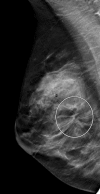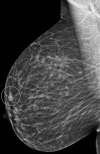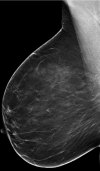Digital Breast Tomosynthesis: Radiologist Learning Curve
- PMID: 30806595
- PMCID: PMC6438358
- DOI: 10.1148/radiol.2019182305
Digital Breast Tomosynthesis: Radiologist Learning Curve
Abstract
Background There is growing evidence that digital breast tomosynthesis (DBT) results in lower recall rates and higher cancer detection rates when compared with digital mammography. However, whether DBT interpretative performance changes with experience (learning curve effect) is unknown. Purpose To evaluate screening DBT performance by cumulative DBT volume within 2 years after adoption relative to digital mammography (DM) performance 1 year before DBT adoption. Materials and Methods This prospective study included 106 126 DBT and 221 248 DM examinations in 271 362 women (mean age, 57.5 years) from 2010 to 2017 that were interpreted by 104 radiologists from 53 facilities in the Breast Cancer Surveillance Consortium. Conditional logistic regression was used to estimate within-radiologist effects of increasing cumulative DBT volume on recall and cancer detection rates relative to DM and was adjusted for examination-level characteristics. Changes were also evaluated by subspecialty and breast density. Results Before DBT adoption, DM recall rate was 10.4% (95% confidence interval [CI]: 9.5%, 11.4%) and cancer detection rate was 4.0 per 1000 screenings (95% CI: 3.6 per 1000 screenings, 4.5 per 1000 screenings); after DBT adoption, DBT recall rate was lower (9.4%; 95% CI: 8.2%, 10.6%; P = .02) and cancer detection rate was similar (4.6 per 1000 screenings; 95% CI: 4.0 per 1000 screenings, 5.2 per 1000 screenings; P = .12). Relative to DM, DBT recall rate decreased for a cumulative DBT volume of fewer than 400 studies (odds ratio [OR] = 0.83; 95% CI: 0.78, 0.89) and remained lower as volume increased (400-799 studies, OR = 0.8 [95% CI: 0.75, 0.85]; 800-1199 studies, OR = 0.81 [95% CI: 0.76, 0.87]; 1200-1599 studies, OR = 0.78 [95% CI: 0.73, 0.84]; 1600-2000 studies, OR = 0.81 [95% CI: 0.75, 0.88]; P < .001). Improvements were sustained for breast imaging subspecialists (OR range, 0.67-0.85; P < .02) and readers who were not breast imaging specialists (OR range, 0.80-0.85; P < .001). Recall rates decreased more in women with nondense breasts (OR range, 0.68-0.76; P < .001) than in those with dense breasts (OR range, 0.86-0.90; P ≤ .05; P interaction < .001). Cancer detection rates for DM and DBT were similar, regardless of DBT volume (P ≥ .10). Conclusion Early performance improvements after digital breast tomosynthesis (DBT) adoption were sustained regardless of DBT volume, radiologist subspecialty, or breast density. © RSNA, 2019 See also the editorial by Hooley in this issue.
Figures





Comment in
-
Are More Experienced Readers Better at Interpreting Digital Breast Tomosynthesis Results?Radiology. 2019 Apr;291(1):43-44. doi: 10.1148/radiol.2019190220. Epub 2019 Feb 26. Radiology. 2019. PMID: 30806602 No abstract available.
References
-
- Marinovich ML, Hunter KE, Macaskill P, Houssami N. Breast cancer screening using tomosynthesis or mammography: a meta-analysis of cancer detection and recall. J Natl Cancer Inst 2018;110(9):942–949. - PubMed
-
- McDonald ES, Oustimov A, Weinstein SP, Synnestvedt MB, Schnall M, Conant EF. Effectiveness of digital breast tomosynthesis compared with digital mammography: outcomes analysis from 3 years of breast cancer screening. JAMA Oncol 2016;2(6):737–743. - PubMed
-
- Friedewald SM, Rafferty EA, Rose SL, et al. . Breast cancer screening using tomosynthesis in combination with digital mammography. JAMA 2014;311(24):2499–2507. - PubMed
-
- Greenberg JS, Javitt MC, Katzen J, Michael S, Holland AE. Clinical performance metrics of 3D digital breast tomosynthesis compared with 2D digital mammography for breast cancer screening in community practice. AJR Am J Roentgenol 2014;203(3):687–693. - PubMed

